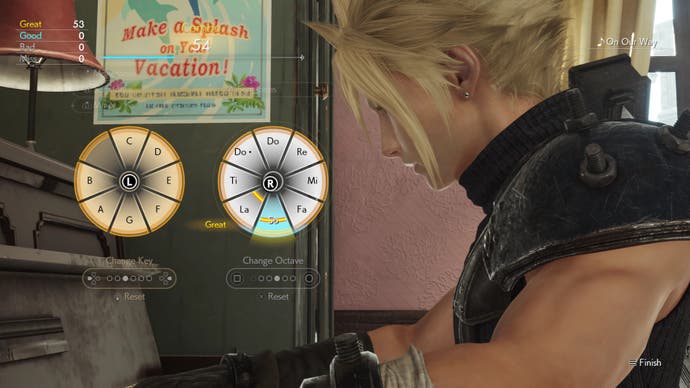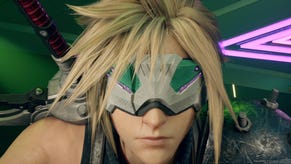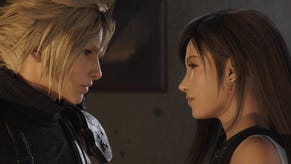I'm going to lose hours playing cards in Final Fantasy 7 Rebirth
Queen's Blood sucker.
The grasslands lay out before me, the greens and blues seemingly luminous compared to the polluted, labyrinthine city of Midgar. The map screen is a tantalising glimpse of how sprawling this particular region is and icons at the top of the screen tempt me towards the main quest. But all I can think about is playing more cards.
The original Final Fantasy 7 had plenty of minigames, but not a card game. It was follow-up Final Fantasy 8 that introduced Triple Triad, which later found new life in Final Fantasy 14, while Final Fantasy 9 gave us the similar Tetra Master, later included in Final Fantasy 11. These card games are some of the most popular minigames in the series - there's now a real life trading card game too.
Which brings us to Final Fantasy 7 Rebirth. Queen's Blood is this game's iteration: not just a fun diversion, but a key example of Square Enix stuffing the game with content to keep players occupied away from the main quest. Perhaps even too much.
So how does it work? Players curate a deck of 15 cards all based on the monsters fought throughout the game. These cards have a power number, a number of pawns, and a Tetris-style shape. The game is played on a board consisting of three lanes with players beginning at opposing sides.
The aim, simply enough, is to amass the most points in each lane. Players can place cards wherever there are pawns, with the Tetris shapes relating to where more pawns will be added to the grid, allowing players to spread across and block opponents. Overlapping these shapes will increase the number of pawns, allowing for more powerful and higher cost cards to be added.
Some cards have abilities too, like boosting the power of cards within certain squares, so placement must be carefully considered to make the most of your deck as cards are randomly shuffled into your hand.

It all seems deceptively simple and initially I breezed through matches. Laying down cards to quickly spread pawns and cover the grid worked nicely at first. The thing is, if opponents lay cards to overlap their pawns with yours, they steal that place on the grid and you lose your advantage. It's best, therefore, to play a slower, more considered march across the board.
Matches can be fairly quick, but there's plenty of space for tactical play. And I can definitely see myself losing hours to this game. It could easily get repetitive but expanding the deck with new cards and more complex shapes will add new layers to strategy. I reached Blood Peasant rank after three matches, but I'll absolutely aim to rapidly rise through the ranks. Just call me the card vampire.
Queen's Blood is also where I found plenty of humour. I played against a man who wouldn't stop crying (apparently this made him stronger); a woman who barricaded herself behind cardboard boxes; and, bizarrely, a ventriloquist child who spoke like she smoked five packets of cigarettes a day. Yes, there may be an evil corporation sucking the very life out of the planet and a crazed war hero on the loose, but there's always time to pause in the street and play a quick card game with a random kid. It's as offbeat and eccentric as Final Fantasy has ever been and a welcome shift from the sometimes dour, apocalyptic tone of the main quest.

Beyond Queen's Blood, there's a tonne of side stuff being added to Final Fantasy 7 Rebirth. The once quiet hamlet of Kalm is now a bustling town filled with people and opportunity - I listened to musicians on the street and spied a moogle cake salesperson. I also visited the bookstore to read a folio, which took me to the game's customisation skill trees - it's here you'll unlock abilities and attributes in a similar fashion to Final Fantasy 10's Sphere Grid. In Nibelheim, meanwhile, I stopped by Tifa's house to play some piano and knocked out a serviceable rendition of the game's main theme, though she berated me for rifling through her closet.
Then I hit the open world. I rode a chocobo as a precursor to the full chocobo racing in the Gold Saucer. I collected materials used to transmute items. And then I met Chadley, who introduced both battle training and towers around the map that require activating to reveal even more things to do - most of which I didn't even have time for in this preview. I was soon trundling off to a giant tree to herd mischievous moogle into a pen while they threw bubbles at me, eager to discover what else the game has in store.

There's an overabundance of distractions that's almost generous to a fault, something splitting the game into a trilogy affords and which Square Enix has taken full advantage of. I was meant to be on my way to battle the game's infamous Midgar Zolom as part of the main quest, but instead I kept wandering off to find more things to do, more enemies to test my battle skills against, more people to play cards with. I could do this for hours.
Will this all prove too much? Perhaps, but I'm not complaining just yet. I'll take any excuse to spend more time in the world of Final Fantasy 7. And with a wealth of fan service throughout Rebirth, that's surely the point.
.jpg?width=690&quality=75&format=jpg&auto=webp)



.png?width=291&height=164&fit=crop&quality=80&format=jpg&auto=webp)








.png?width=291&height=164&fit=crop&quality=80&format=jpg&auto=webp)



